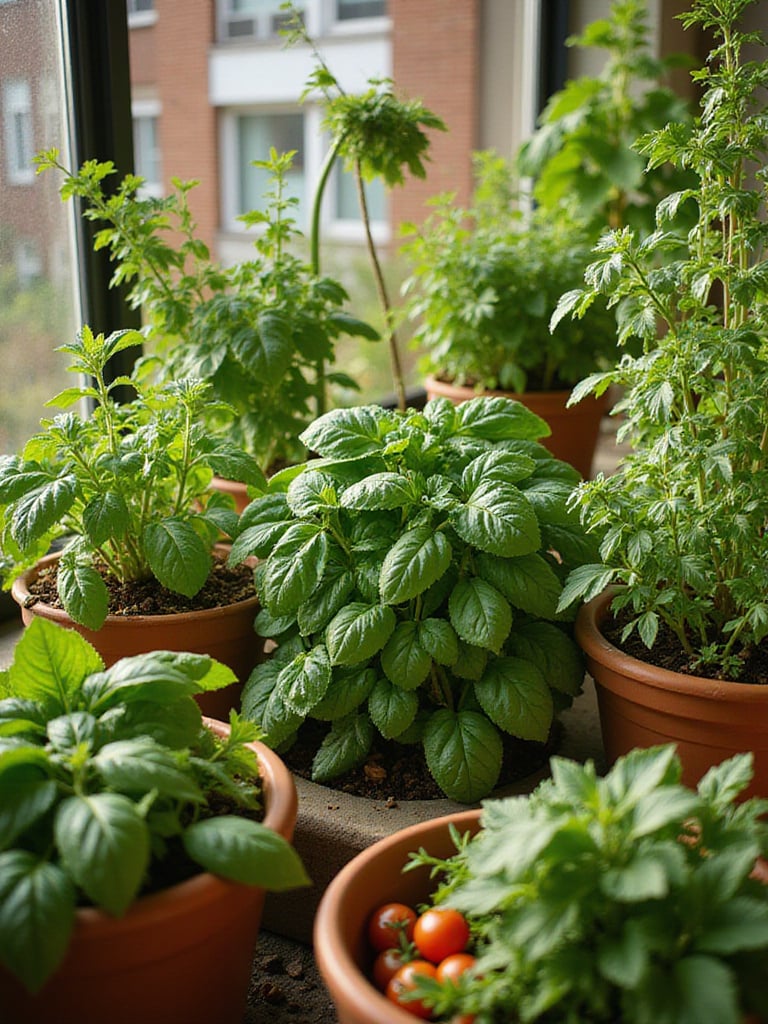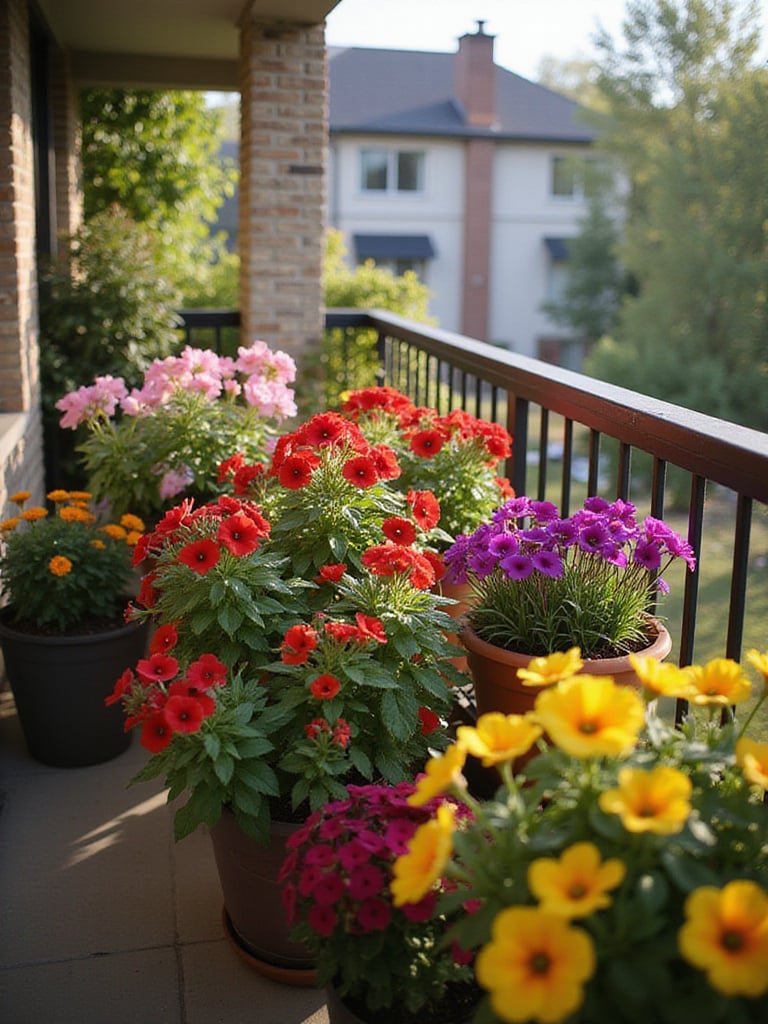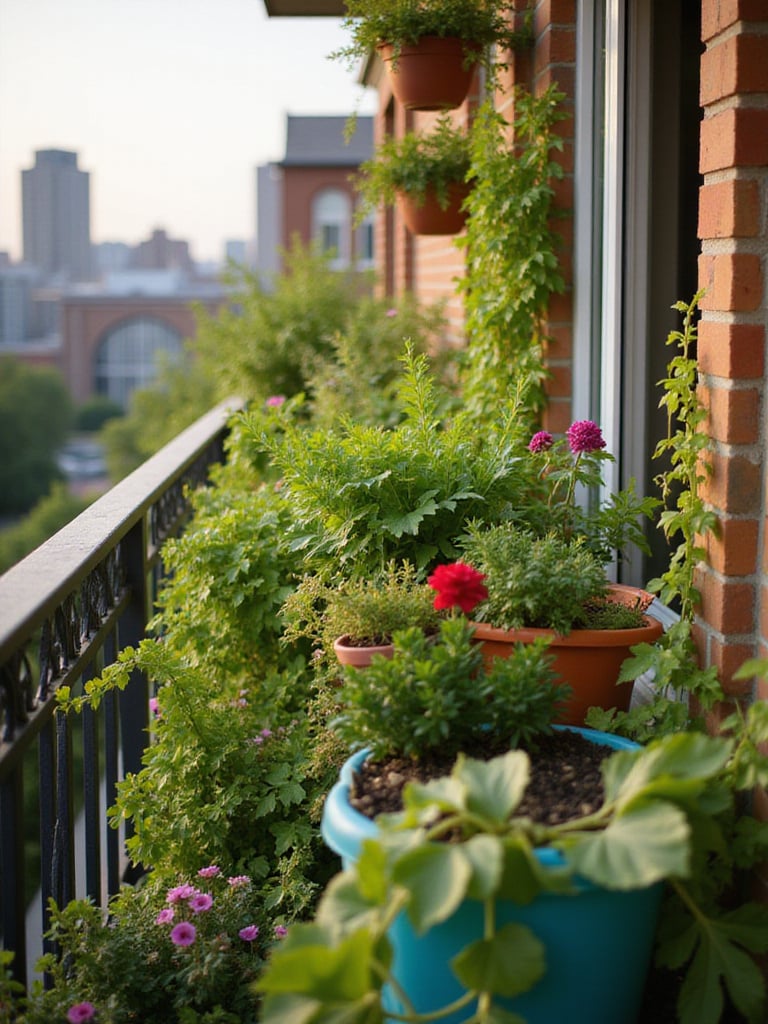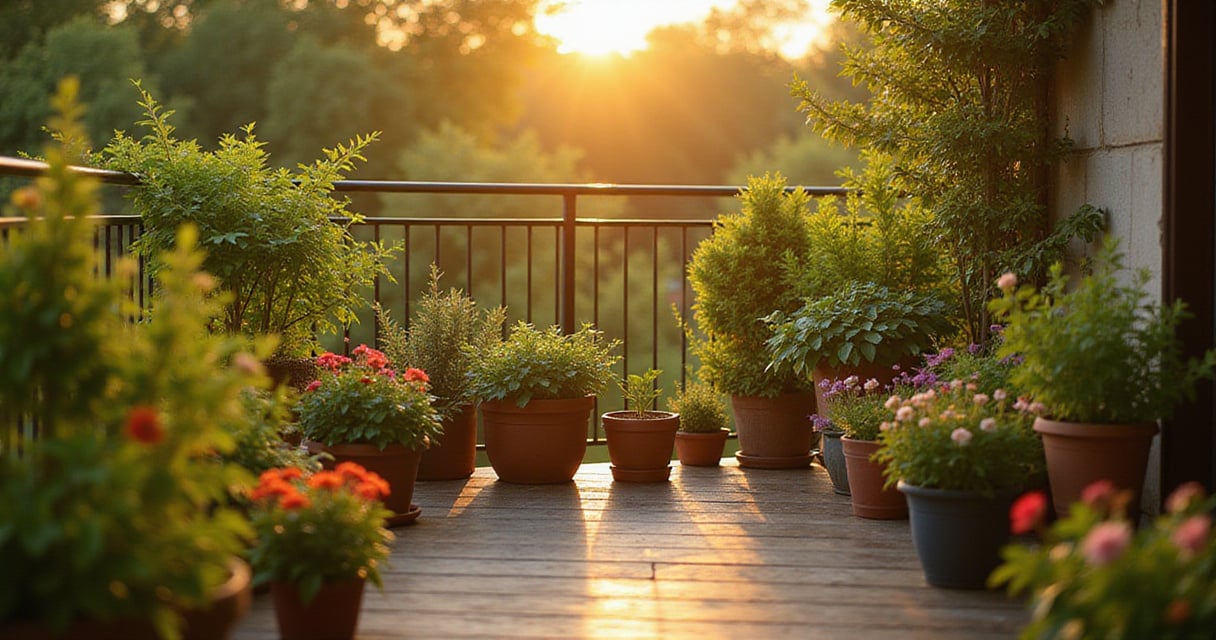That forgotten corner of your balcony doesn’t have to stay bare concrete forever. Picture stepping outside to find vibrant herbs ready for tonight’s dinner, cascading flowers that make your neighbors pause in admiration, and the kind of green sanctuary that makes you forget you’re stories above the city streets. Your balcony holds incredible potential – it just needs the right approach.
Most people think small spaces mean limited options, but that’s where they’re wrong. With smart plant choices and a few insider techniques, even a tiny balcony can become more productive and beautiful than you ever imagined. Whether you’re dealing with harsh afternoon sun, tricky shade, or the challenge of keeping plants alive during your busy schedule, these 21 essential tips will transform your approach to balcony plants. You’ll discover which varieties practically take care of themselves, how to multiply your favorites without spending extra money, and the simple mistakes that trip up even experienced gardeners.
1. Know Your Balcony’s Sun Story Before Buying a Single Plant
Your balcony’s light patterns tell a story that changes throughout the day and across seasons – and understanding this story is absolutely crucial before you invest in any balcony plants. I learned this lesson the hard way when I placed sun-loving tomatoes in what I thought was a bright spot, only to watch them struggle because a neighboring building cast afternoon shadows I hadn’t noticed.

Start by spending a few days observing your space hourly, noting where direct sunlight hits and for how long. Full sun means 6+ hours of direct light, partial sun is 3-6 hours, and anything less counts as shade. But here’s what most people miss: seasons change everything. That sunny summer spot might become deeply shaded in winter when the sun’s angle drops. Take photos throughout the day and keep notes – this detective work will save you money and heartbreak later.
- Morning trackers: Note which areas get gentle morning sun (perfect for leafy greens)
- Afternoon scorchers: Identify spots that get intense afternoon heat (ideal for Mediterranean herbs)
- Seasonal shifters: Mark areas where shadows change dramatically between seasons
The craftsmanship reveals itself in details like how you match each plant to its perfect light zone, creating a thriving ecosystem rather than a collection of struggling survivors.
2. Choose Containers That Actually Support Plant Dreams
The container you choose literally shapes your plant’s entire life – from how often you’ll need to water to whether those tomatoes will actually produce fruit. I’ve watched too many gardeners wonder why their balcony plants stay stunted, not realizing their 6-inch pots are essentially plant prisons for varieties that need room to spread.

Size matters more than you think. Those cherry tomatoes need at least 5-gallon containers to produce abundantly, while herbs can thrive in smaller spaces. But size isn’t everything – material makes a huge difference too. Terracotta breathes and keeps roots cooler in hot climates, while plastic retains moisture better in windy spots. Dark containers can cook roots in direct sun, so choose light colors or materials that moderate temperature naturally.
Drainage isn’t optional – it’s survival. Every container must have holes at the bottom, roughly one half-inch hole per foot of diameter. I’ve seen beautiful ceramic pots kill plants simply because water had nowhere to go. If you fall in love with a pot without drainage, use it as a decorative outer container with a properly draining pot inside.
What makes this choice better for our planet is selecting containers that last for years rather than cheap options that crack after one season, reducing waste while supporting healthier plant growth.
3. Master the Art of Low-Maintenance Plant Selection
The secret to a thriving balcony garden isn’t having a green thumb – it’s choosing balcony plants that want to succeed in your specific conditions. After years of trial and error, I’ve learned that fighting against a plant’s natural preferences is exhausting and expensive. Smart plant selection can turn you from a plant killer into a plant whisperer almost overnight.

Focus on varieties bred for resilience rather than just beauty. Mediterranean herbs like rosemary and thyme actually prefer neglect over fussing. Succulents store water in their leaves, making them nearly indestructible for busy schedules. Native plants adapted to your local climate will always outperform exotic varieties that need constant coddling.
- Drought warriors: Lavender, sedum, and portulaca thrive with minimal watering
- Shade champions: Coleus, impatiens, and ferns flourish in low-light conditions
- Heat lovers: Zinnias, marigolds, and peppers actually prefer hot, sunny spots
Group plants with similar needs together – this simple strategy eliminates the guesswork from daily care and prevents the common mistake of overwatering drought-lovers or underwatering moisture-lovers.
Beyond the obvious placement, consider using this approach to create themed sections that simplify your entire care routine.
4. Turn Your Balcony Into a Mini Farm That Actually Produces
Growing your own food on a balcony isn’t just possible – it’s incredibly rewarding and more productive than most people realize. The key is thinking vertically and choosing varieties bred for container life. I’ve harvested enough herbs from a 3×5 foot balcony to supply my kitchen year-round, plus enough cherry tomatoes to share with neighbors.

Start with herbs since they’re nearly foolproof and expensive to buy fresh. Basil, mint, and chives grow quickly and keep producing if you harvest regularly. For vegetables, choose compact varieties: bush beans instead of pole beans, cherry tomatoes instead of beefsteak, and leafy greens that you can succession plant every few weeks for continuous harvests.
The magic happens when you embrace succession planting – sowing small amounts every 2-3 weeks instead of everything at once. This prevents the feast-or-famine cycle and ensures fresh salads all season long. A single 5-gallon container can produce 10-15 pounds of cherry tomatoes over a growing season, making it more productive per square foot than most ground gardens.
- Quick producers: Radishes and lettuce ready in 30-45 days
- Continuous harvesters: Herbs and leafy greens that regrow after cutting
- Space maximizers: Vertical varieties like climbing peas and pole beans
The unexpected pairing that always works is combining fast-growing crops with slower ones in the same container, maximizing your harvest timeline.
5. Create a Color Explosion That Blooms All Season
Choosing flowering balcony plants for continuous color requires thinking beyond just pretty blooms – you need varieties that keep performing month after month without constant deadheading or replacement. The secret is selecting plants bred for endurance rather than just initial impact.

Look for terms like “self-cleaning” or “continuous blooming” on plant tags. Calibrachoa (Million Bells) and petunias bred for heat tolerance will bloom from spring until frost without stopping. Verbena and lantana actually get better as the season progresses, becoming more drought-tolerant and floriferous. These workhorses might cost slightly more initially, but they’ll save you money and effort throughout the growing season.
Color planning prevents that “random flower shop” look that screams amateur. Choose a palette of 2-3 colors plus white, then stick to it. Hot colors (reds, oranges, yellows) energize small spaces, while cool colors (blues, purples, whites) create calm sophistication. Don’t forget foliage – plants with colorful leaves like coleus provide consistent color even when flowers take a break.
- Heat-proof bloomers: Vinca, zinnia, and celosia thrive in scorching conditions
- Shade performers: Impatiens, begonias, and torenia brighten dim corners
- Fragrant additions: Sweet alyssum and nicotiana add evening perfume
The visual weight balances perfectly when you place your boldest colors at eye level and let softer hues fill in around them.
6. Crack the Code on Perfect Watering Timing
Watering balcony plants correctly isn’t about following a schedule – it’s about reading what your plants actually need. The biggest mistake I see is watering by calendar instead of by soil condition. Plants in different sized pots, different materials, and different locations all have unique water needs that change with weather, season, and growth stage.

The finger test never fails: stick your index finger 2 inches deep into the soil. If it feels dry at that depth, it’s time to water. If it’s still moist, wait another day. When you do water, do it thoroughly until water runs out the drainage holes. This deep watering encourages roots to grow down rather than staying shallow and vulnerable.
Timing matters as much as technique. Early morning watering gives plants time to absorb moisture before the day’s heat increases evaporation. Evening watering in hot climates can work too, but avoid getting leaves wet at night since this can encourage fungal problems. Wind and heat dramatically increase water needs – your plants might need daily watering during heat waves but only weekly during cool, humid periods.
Morning light filters through, revealing the texture of properly moist soil that supports vigorous growth rather than stressed, wilted plants.
7. Go Vertical and Triple Your Growing Space
Vertical gardening isn’t just trendy – it’s essential for making the most of limited balcony space. By thinking in three dimensions instead of just floor space, you can grow three times as many balcony plants without your balcony feeling cramped. The key is choosing the right system for your specific setup and plant goals.

Wall-mounted pocket planters work brilliantly for herbs and small flowers, while tiered plant stands create levels without permanent installation. For renters, freestanding vertical towers or hanging systems offer maximum flexibility. Trellises turn any climbing plant into a living wall – try morning glories for quick coverage or clematis for long-term beauty.
Consider weight distribution carefully. Spread heavy planters across your balcony rather than concentrating them in one area. Use lightweight containers and soilless potting mixes for upper levels. Most balconies can handle more weight than people assume, but check with your building management if you’re planning something substantial.
- Climbing stars: Pole beans, peas, and nasturtiums grow up instead of out
- Trailing beauties: Ivy geraniums and bacopa spill elegantly from upper containers
- Compact uprights: Dwarf sunflowers and compact tomatoes maximize vertical real estate
The composition comes together when you layer different heights and textures, creating depth that makes even tiny balconies feel lush and abundant.
8. Build Living Privacy Screens That Actually Work
Creating privacy with balcony plants serves double duty – blocking unwanted views while adding natural beauty to your space. The trick is choosing plants that grow tall and dense enough to provide real screening without taking over your entire balcony. Strategic placement can create intimate spaces even in high-density urban settings.

Clumping bamboo varieties like Fargesia offer year-round screening and elegant movement in the breeze. For seasonal options, try tall ornamental grasses or columnar evergreens in large containers. Climbing vines on trellises create green walls quickly – jasmine adds fragrance while clematis provides seasonal flowers.
Consider your neighbors when planning privacy screens. Plants that grow too tall might block their light or views, creating conflicts. Choose varieties that max out at reasonable heights (6-8 feet) and keep them well-maintained. Good fences make good neighbors, but thoughtful plant screens make great ones.
The sustainable journey of this material involves selecting plants that provide privacy for years rather than quick-fix solutions that need constant replacement.
9. Let Plants Spill Over Edges for Instant Charm
Trailing balcony plants are the secret weapon for transforming rigid container gardens into flowing, natural-looking displays. These “spillers” soften hard edges and create the illusion of abundance even in small spaces. The cascading effect draws the eye downward, making your balcony feel larger and more integrated.

Choose trailing varieties based on your light conditions and color scheme. Sweet potato vine offers dramatic foliage in chartreuse or deep purple, while bacopa provides delicate white or blue flowers. Ivy geraniums combine beautiful blooms with graceful trailing habit, perfect for window boxes or elevated planters.
Placement strategy matters – put trailing plants where their cascading growth won’t interfere with foot traffic or furniture. Window boxes along railings, hanging baskets at corners, and elevated planters create perfect opportunities for spillers to shine without getting in the way.
- Sun spillers: Portulaca, nasturtiums, and calibrachoa love bright conditions
- Shade trailers: Ivy, vinca vine, and begonias thrive in lower light
- Edible cascaders: Cherry tomatoes, trailing strawberries, and creeping thyme
The finishing touch that elevates the entire look comes from combining different trailing textures and colors in the same planter for maximum visual impact.
10. Feed Your Plants Right for Maximum Blooms
Container-grown balcony plants are completely dependent on you for nutrition since they can’t send roots into garden soil to find nutrients. Unlike ground-planted gardens, containers become nutrient deserts within 6-8 weeks, making regular feeding essential for continued growth and flowering.

The “weakly weekly” approach works better than heavy monthly feeding for most flowering plants. Dilute liquid fertilizer to quarter-strength and apply weekly during active growing season. This provides steady nutrition without the feast-or-famine cycle that stresses plants. For low-maintenance gardeners, slow-release granules mixed into potting soil provide steady feeding for 3-4 months.
Different plants need different nutrition ratios. Flowering plants benefit from higher phosphorus (the middle number in fertilizer ratios) to promote blooms, while leafy crops need more nitrogen for green growth. Organic options like fish emulsion or compost tea improve soil biology while feeding plants, creating healthier growing conditions overall.
- Bloom boosters: Look for fertilizers with higher middle numbers (like 10-15-10)
- Foliage feeders: Balanced ratios (like 10-10-10) support overall plant health
- Organic options: Fish emulsion, kelp meal, and compost tea build soil health
The environmental story behind this piece began with understanding that healthy, well-fed plants resist pests and diseases naturally, reducing the need for chemical interventions.
11. Outsmart Pests Without Toxic Chemicals
Preventing pest problems on balcony plants starts with creating conditions that favor plant health over pest reproduction. Healthy plants naturally resist most pest attacks, while stressed plants send out chemical signals that actually attract trouble. This means proper watering, adequate nutrition, and good air circulation are your first lines of defense.

Early detection beats treatment every time. Check your plants weekly, looking at leaf undersides where many pests hide. Aphids cluster on new growth, spider mites create fine webbing, and whiteflies flutter up when disturbed. Catching problems early means simple solutions like spraying off aphids with water or hand-picking larger pests.
When treatment becomes necessary, start with the gentlest effective option. Insecticidal soap works on soft-bodied insects, while neem oil handles a broader range of pests. Both break down quickly and don’t harm beneficial insects when used correctly. Beneficial insects like ladybugs and lacewings can be purchased online and released for biological control.
- Prevention tactics: Proper spacing, good drainage, and adequate nutrition
- Early intervention: Daily observation and immediate action on first signs
- Gentle treatments: Water sprays, insecticidal soap, and beneficial insects
The challenge of awkward spaces becomes easier when you understand that healthy plants in optimal conditions rarely develop serious pest problems.
12. Keep Tender Plants Alive Through Winter
Overwintering tender balcony plants can save hundreds of dollars annually while preserving varieties that might be hard to find again. Many plants we treat as annuals are actually perennials in warmer climates – geraniums, fuchsias, and rosemary can live for decades with proper winter care.

Timing the transition indoors is crucial. Bring plants inside before nighttime temperatures consistently drop below 50°F, but don’t wait for the first frost warning. Gradual acclimation works better than sudden changes – start by bringing plants in at night and back out during the day for a week before permanent indoor residence.
Indoor winter conditions require adjustment. Most overwintering plants prefer cool (50-60°F), bright conditions with reduced watering. A south-facing window or supplemental grow lights provide necessary light, while cooler temperatures keep plants dormant rather than trying to actively grow in low-light conditions.
Preparation includes cutting back growth by one-third to one-half, reducing the plant’s energy needs during dormancy. Check carefully for hitchhiking pests before bringing plants indoors – a few aphids can multiply quickly in warm indoor conditions.
The artisan collective that creates these pieces understands that overwintered plants develop stronger root systems and more robust growth habits than first-year plants.
13. Roll Out the Welcome Mat for Pollinators
Creating pollinator habitat on your balcony supports declining bee and butterfly populations while improving yields from any edible balcony plants you’re growing. Even small urban balconies can provide crucial resources for pollinators moving through city environments, creating stepping stones between larger habitat areas.

Native plants provide the best nutrition for local pollinators, but many common garden flowers also attract beneficial insects. The key is providing blooms throughout the growing season – early spring flowers for emerging bees, summer abundance for peak activity, and late-season blooms for butterflies preparing for migration or winter survival.
Flower shape matters as much as timing. Flat, open flowers like zinnias and cosmos provide easy landing platforms for many insects, while tubular flowers like salvia attract specialized pollinators. Single flowers generally provide more nectar and pollen than double varieties, which often have their reproductive parts replaced with extra petals.
- Spring bloomers: Crocus, primrose, and early herbs like chives
- Summer workhorses: Zinnias, cosmos, and native wildflowers
- Fall finishers: Asters, goldenrod, and late-blooming herbs
Avoid all pesticides, even organic ones, during bloom periods when pollinators are actively foraging. The unexpected environmental benefit comes from supporting urban biodiversity in spaces that might otherwise contribute nothing to local ecosystems.
14. Create Your Dream Theme Garden
Themed balcony gardens provide design direction while simplifying plant and decor choices. Whether you choose Mediterranean drought-tolerance, tropical lushness, or zen minimalism, a clear theme prevents the “plant shopping impulse” purchases that create chaotic, uncoordinated displays.

Mediterranean themes work brilliantly for hot, sunny balconies with plants like lavender, rosemary, olive trees, and ornamental grasses in terracotta containers. Add gravel mulch and maybe a small water feature for authenticity. Tropical themes suit humid climates or shaded balconies with bold foliage plants, bright flowers, and natural materials like bamboo and rattan.
Zen gardens emphasize simplicity and natural materials – think carefully chosen plants with interesting forms, natural stone elements, and plenty of negative space. The goal is creating calm contemplation rather than overwhelming abundance.
- Mediterranean essentials: Drought-tolerant herbs, silver-leafed plants, terracotta pots
- Tropical must-haves: Bold foliage, bright flowers, natural textures
- Zen fundamentals: Simple forms, natural materials, thoughtful spacing
The cultural heritage preserved in each piece includes understanding how different garden traditions solve the challenges of small-space gardening.
15. Make Every Square Inch Count
Maximizing small balcony space requires thinking like a puzzle solver – every element should serve multiple purposes while contributing to the overall design. Smart balcony plants placement can create the illusion of much larger space while providing maximum growing area for your favorite varieties.

Vertical growing is obvious, but corner utilization often gets overlooked. Corner plant stands, hanging baskets in corners, and triangular planters designed for corners make use of spaces that otherwise go unused. Railing planters don’t take any floor space while providing substantial growing area for herbs, flowers, or trailing plants.
Multi-functional furniture serves double duty – storage benches hold potting supplies while providing seating, while plant stands with multiple tiers display plants at different heights. Rolling plant carts let you move heavy containers easily and can be tucked away when you need floor space for entertaining.
Layer plants at different heights to create depth and visual interest. Tall plants against walls or in corners, medium plants in the middle ground, and trailing plants spilling from elevated positions create the impression of a much larger garden space.
The evolution of this trend reflects broader cultural shifts toward maximizing small urban spaces while maintaining connection to nature and growing food.
16. Choose Plants That Practically Water Themselves
Drought-tolerant balcony plants aren’t just water-wise – they’re also more forgiving of irregular care schedules and harsh balcony conditions like wind and reflected heat. These plants have evolved strategies for surviving dry periods, making them naturally resilient and low-maintenance.

Look for plants with water-storing adaptations: thick, fleshy leaves (succulents), silver or fuzzy foliage (reflects heat and reduces water loss), or deep root systems. Mediterranean herbs, ornamental grasses, and many native plants fall into this category. These plants often prefer less frequent, deeper watering over daily sprinkles.
Soil choice matters enormously for drought-tolerant plants. They need excellent drainage to prevent root rot during wet periods. Add extra perlite or coarse sand to regular potting mix, or use specialized cactus and succulent soil for the most water-sensitive varieties.
- Succulent superstars: Sedum, echeveria, and jade plants store water in leaves
- Herb heroes: Rosemary, thyme, and oregano thrive on neglect
- Grass champions: Ornamental grasses add movement with minimal water needs
Mulching with decorative gravel or small stones reduces evaporation while adding visual appeal to drought-tolerant plantings.
Unlike conventional options, this approach reduces both water consumption and the stress of keeping plants alive during busy periods or vacation absences.
17. Master Drainage or Watch Your Plants Drown
Proper drainage prevents more balcony plants deaths than any other single factor. Container plants sitting in waterlogged soil develop root rot quickly, especially in the limited soil volume of pots. The roots literally suffocate from lack of oxygen, leading to yellowing leaves, wilting, and eventual plant death.

Every container must have drainage holes – no exceptions. One half-inch hole per 12 inches of container diameter provides adequate drainage for most plants. If you fall in love with a decorative pot without holes, use it as a cache pot with a properly draining liner inside, or drill holes yourself with a masonry bit.
The old advice about adding gravel to pot bottoms actually makes drainage worse by creating a “perched water table” that keeps soil above it saturated. Instead, use quality potting mix that drains well throughout and elevate pots on feet or blocks to ensure water can escape freely.
Check drainage by watering thoroughly and observing how quickly excess water runs out the bottom. Water should drain steadily, not pool on the surface or drain so fast that soil washes out. Adjust your potting mix if drainage seems too slow or too fast.
The traditional methods used result in healthier root systems that can support larger, more productive plants throughout the growing season.
18. Multiply Your Favorites for Free
Propagating balcony plants transforms you from plant purchaser to plant producer, dramatically expanding your collection while preserving favorite varieties. Many common balcony plants root easily from cuttings, allowing you to create multiple plants from single purchases or share favorites with friends.

Herbs like basil, mint, and rosemary root readily in water or moist potting mix. Take 4-6 inch cuttings from healthy, non-flowering stems, remove lower leaves, and place in water or rooting medium. Most cuttings develop roots within 2-3 weeks under proper conditions.
Timing matters for successful propagation. Take cuttings from actively growing plants during their peak growing season, typically late spring through early fall. Avoid stressed plants or those preparing for dormancy. Morning cuttings often root better since plants are fully hydrated from overnight moisture absorption.
Success rates improve dramatically with consistent moisture and humidity around cuttings. Cover with plastic bags or use humidity domes to maintain moisture while roots develop. Bright, indirect light provides energy for root development without stressing the cutting.
- Water rooters: Basil, mint, coleus, and impatiens root easily in water
- Soil rooters: Rosemary, lavender, and geraniums prefer moist potting mix
- Division candidates: Ornamental grasses and perennial herbs multiply through division
The discovery of this technique happened when gardeners realized that many plants naturally reproduce through broken stems or fallen leaves in nature.
19. Embrace the Beauty of Shade-Loving Plants
North-facing balconies and other low-light spaces can be just as beautiful as sunny locations with the right balcony plants selection. Shade plants often feature more interesting foliage than sun plants, creating lush, tropical-looking displays even in challenging light conditions.

Foliage plants provide consistent color and interest without depending on flowers. Coleus offers incredible variety in leaf colors and patterns, while caladiums provide heart-shaped leaves in combinations of pink, white, and green. Ferns add texture and movement, creating the feeling of a woodland retreat.
Many shade plants prefer consistent moisture and higher humidity than sun plants. Group shade-loving plants together to create beneficial microclimates, and consider adding pebble trays or small water features to increase local humidity levels.
Don’t assume shade means no flowers – impatiens, begonias, and torenia bloom prolifically in partial shade conditions. These plants often prefer the protection from intense afternoon sun and may actually perform better in bright shade than full sun locations.
The maker’s journey from apprentice to master influenced the understanding that shade gardening requires different skills but offers unique rewards in terms of lush, cooling green spaces.
20. Choose Potting Mix Like Your Plants’ Lives Depend on It
Quality potting mix makes the difference between thriving balcony plants and struggling survivors. Garden soil compacts in containers, preventing proper drainage and root development. Soilless potting mixes stay loose and well-draining while providing the right balance of moisture retention and aeration.

Different plants need different soil characteristics. Succulents and Mediterranean herbs require fast-draining, gritty mixes, while ferns and tropical plants prefer moisture-retentive formulations. Vegetables and annual flowers do well in balanced, general-purpose potting mixes with added compost or slow-release fertilizer.
Read ingredient lists when choosing potting mix. Look for combinations of peat moss or coconut coir (moisture retention), perlite or vermiculite (drainage and aeration), and compost or bark (nutrition and structure). Avoid mixes that contain actual soil, which can compact and drain poorly in containers.
Quality potting mix costs more initially but provides better plant performance and longer container life. Cheap mixes often contain too much bark or uncomposted organic matter that robs nitrogen from plants as it decomposes.
The investment value comes from the exceptional plant performance and reduced replacement costs when plants thrive in proper growing medium.
21. Transform Your Space with Lighting and Style
Balcony plants provide the foundation, but thoughtful lighting and decorative elements complete the transformation from utilitarian space to outdoor living room. Strategic lighting extends usability into evening hours while highlighting your plants’ beauty after dark.

String lights provide ambient lighting that makes any balcony feel magical, while solar spotlights can highlight specimen plants or architectural features. Battery-powered LED options eliminate the need for electrical work in rental situations. Layer different types of lighting for maximum flexibility – ambient for overall glow, accent for highlighting features, and task lighting for specific activities.
Furniture should be proportional to your space and serve multiple functions when possible. Folding bistro sets provide dining space without permanent commitment, while storage benches hold supplies and provide seating. Weather-resistant cushions and throws add comfort and color while softening hard surfaces.
Decorative elements should complement rather than compete with your plants. Simple is usually better in small spaces – a few well-chosen pieces create more impact than cluttered collections.
- Lighting layers: Ambient string lights, accent spotlights, task table lamps
- Multi-function furniture: Storage benches, folding tables, stackable stools
- Weather-resistant accessories: Outdoor cushions, throws, and decorative objects
The emotional response this evokes begins with creating a space so inviting that you naturally want to spend time there, surrounded by the balcony plants you’ve nurtured into a thriving garden sanctuary.
Your Balcony Paradise Awaits
These 21 essential tips have equipped you with everything needed to transform your balcony from an overlooked space into a thriving plant paradise. You now understand how to assess your unique conditions, choose plants that will actually succeed, and create systems that work with your lifestyle rather than against it. From the fundamentals of proper drainage and container selection to the finer points of seasonal care and propagation, you have a complete roadmap for balcony plants success.
The beauty of balcony gardening lies not just in the plants themselves, but in the daily connection to growing things, the satisfaction of harvesting your own herbs, and the peace that comes from creating your own green sanctuary. Whether you start with a single pot of herbs or dive into a complete balcony transformation, each plant you successfully grow builds confidence and skills for the next gardening adventure.
Your balcony holds incredible potential – it’s time to unlock it. Start with one or two tips that resonate most with your situation, then gradually expand your knowledge and plant collection. Before you know it, you’ll be the neighbor everyone asks for gardening advice, surrounded by the lush, productive balcony plants that once seemed impossible in your small space.










